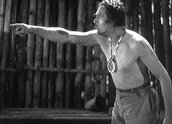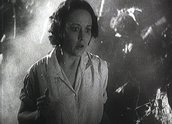


Uncivilised (1936)
Synopsis
Beatrice Lynn (Margot Rhys), a successful novelist, journeys into the ‘unexplored’ reaches of north-west Australia in search of book material. She has heard rumours of a ‘wild white man’ who lives with Aboriginal people, but she finds more than she expected. She is abducted by an Afghan trader (Ashton Jarry) and sold to Mara the white chief (Dennis Hoey). Opium smugglers try to buy Mara’s collection of fabulous rubies, as war breaks out between Mara and a renegade Aboriginal warrior called Moopil. Beatrice finds she is falling in love with Mara, as a great battle begins.
Curator’s notes
The movie is indeed, uncivilised, a product of the rampant racist modes of some Hollywood adventure films of the time. Charles Chauvel, son of a Queensland grazier from Warwick, had absorbed much Hollywood technique in his first two visits to the American movie capital in the 1920s. He had made four features by the time he came to direct Uncivilised, and these had generally been successful, although penetrating the American market had proved difficult. Uncivilised was a more direct expression of the old saying – if you can’t beat them, join ’em.
It’s basically an Australian Tarzan film, but with an English singer Dennis Hoey, as the king of the jungle. Chauvel threw everything he could think of into the film’s potent cocktail – native dancing, a full-scale and quite violent tribal war, a subplot about rubies and opium, a couple of songs from Hoey, and a nude swim from his leading actress, Margot Rhys. Hoey also got to strangle Moopil, the renegade Aboriginal person (the actor is not credited) and both of these scenes caused trouble with the Australian censors. The film was shown uncut in Australia, but these scenes had to be trimmed for export – a curious double standard. The north-west Aboriginal people are largely from Northern Queensland and Palm Island, where Chauvel spent six weeks filming. About 20 Palm Island Aboriginal people were then flown to Sydney for scenes completed at the National Studios in Pagewood. The film remains very much a product of its time, with an anti-miscegenation streak in the plot, and characters defined more by race than anything else.
Secondary curator’s notes
by Romaine MoretonUncivilised parallels the first feature film released in the USA, Birth of a Nation, both narratives drawing on relationships between the white and black population. In the Australian context, this becomes a conversation about the civilised and the uncivilised. Uncivilised has a subtext true to the social belief of the time that the landscape and Aboriginal culture would make the whites turn native. The white, Tarzan-like main character, who has essentially 'turned primitive’, represents the gradual seduction of the land. A real frontier story, it includes very English concepts of colonialism and the savage. The white chief, Mara (Dennis Hoey), is a black man in white man’s skin whose spoken English is broken, but who is suddenly eloquent when he breaks into operatic song.
Uncivilised merely uses Aboriginal people to talk about the wild white man. It carries the strong message that it is morally wrong to procreate between the races (miscegenation). It is very much a western interpretation of Indigenous culture, and no part of this film should be taken as a true account of Indigenous culture and peoples. In one scene, an Aboriginal woman played by a white actress in blackface cackles like a witch – a white interpretation of an Aboriginal woman perhaps, that draws parallels between witchcraft and Indigenous culture. The mix of operatic vocal within a primitive setting is quite comical, as is the use of blackface – using makeup to make white actors appear black or black actors blacker. The result is a convoluted mix of evilness and distortion. In Indigenous produced theatre and cinema, the rejection of blackface was one of the first items included in the protocols developed by Lester and Gerry Bostock in dealing with Aboriginal content.
Uncivilised is a good example of the danger of knowing a little, for it is a little bit of knowledge of Indigenous culture that Chauvel exploits to speak about the white man’s struggle against turning from the civilised into the uncivilised.
- Overview
- Curator’s notes
- Video 3 clips
- Principal credits
- Find a copy
- Comments 1
- Map
- Add your review




